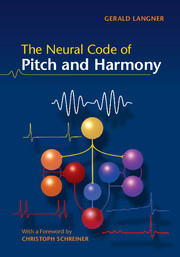Book contents
- Frontmatter
- Contents
- Preface
- Foreword
- 1 Historical aspects of harmony
- 2 Sound and periodicity
- 3 The discovery of the missing fundamental
- 4 The pitch puzzle
- 5 The auditory time constant
- 6 Pathways of hearing
- 7 Periodicity coding in the brainstem
- 8 Periodicity coding in the midbrain
- 9 Theories of periodicity coding
- 10 Periodotopy
- 11 The neural code of harmony
- 12 The oscillating brain
- References
- Index
10 - Periodotopy
Published online by Cambridge University Press: 05 May 2015
- Frontmatter
- Contents
- Preface
- Foreword
- 1 Historical aspects of harmony
- 2 Sound and periodicity
- 3 The discovery of the missing fundamental
- 4 The pitch puzzle
- 5 The auditory time constant
- 6 Pathways of hearing
- 7 Periodicity coding in the brainstem
- 8 Periodicity coding in the midbrain
- 9 Theories of periodicity coding
- 10 Periodotopy
- 11 The neural code of harmony
- 12 The oscillating brain
- References
- Index
Summary
Spatial representation of pitch
Mapping from time to place
Tonotopic maps are typical examples of how perceptual parameters can be represented in the nervous system. Information about acoustic frequency is represented by an orderly topographic arrangement of neurons according to their individual frequency tuning (CF). As we have seen in the last chapters, disc-shaped cells in the inferior colliculus are usually tuned in two ways. They have a preference for a certain CF, because they receive their input from a particular location in the cochlea. In addition they act as coincidence detectors that are tuned to the periodic envelopes of harmonic signals. These neurons therefore preferentially respond to signals in a more or less narrow frequency range, especially if these signals are modulated with the ‘right’ (best) modulation frequency (BMF).
As a result of coincidence detection, temporal information is to a certain extent transferred into a rate (activation) code. On the other hand, synchronization deteriorates strongly for modulation frequencies above 300 Hz in the auditory midbrain and above 100 Hz in the cortex (Langner, 1992). It seems therefore reasonable to assume that the loss of temporal information must somehow be compensated for and that it could possibly be transformed into a spatial code. Accordingly, we were able to show that, as a result of the time analysis in the brainstem and the inferior colliculus, periodicity is represented topographically in a periodotopic map (Schreiner and Langner, 1988).
A black-box model of a subpart of the periodicity processing network (Fig. 10.1) shows how the periodicity analysis may result in a common map for frequency and periodicity. On the left side the frequency analysis of a small part of the cochlea is shown as a filter bank with many parallel channels (hair cells). The time information from these parallel channels is transferred with different delays via the dorsal and ventral parts of the cochlear nucleus (CN) to one of about 30 neuronal layers in the inferior colliculus.
- Type
- Chapter
- Information
- The Neural Code of Pitch and Harmony , pp. 143 - 161Publisher: Cambridge University PressPrint publication year: 2015



